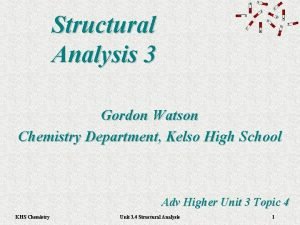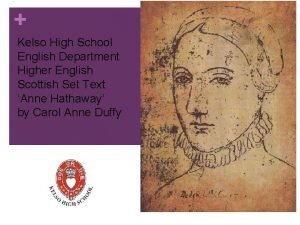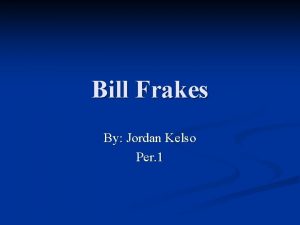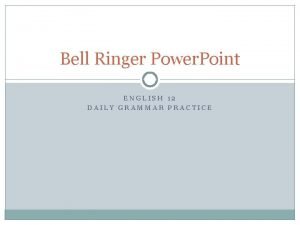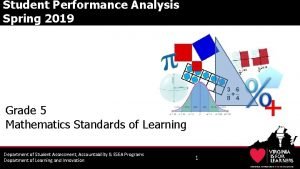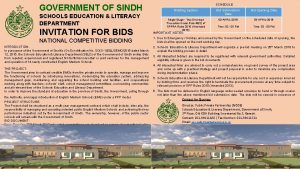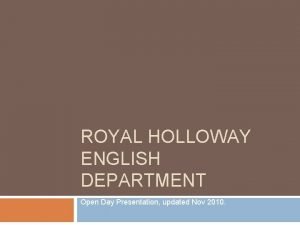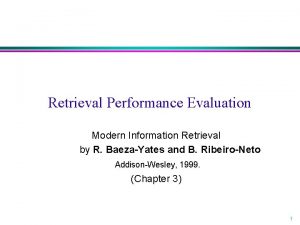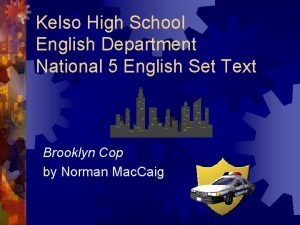Kelso High School English Department National 5 English









































- Slides: 41

Kelso High School English Department National 5 English Set Text - Mac. Caig

Aunt Julia spoke Gaelic very loud and very fast. I could not answer her — I could not understand her. She wore men's boots when she wore any. — I can see her strong foot, stained with peat, paddling with the treadle of the spinning wheel while her right hand drew yarn marvellously out of the air.

Hers was the only house where I've lain at night in the absolute darkness of a box bed, listening to crickets being friendly. She was buckets and water flouncing into them. She was winds pouring wetly round house-ends. She was brown eggs, black skirts and a keeper of threepennybits in a teapot.

Aunt Julia spoke Gaelic very loud and very fast. By the time I had learned a little, she lay silenced in the absolute black of a sandy grave at Luskentyre. But I hear her still, welcoming me with a seagull's voice across a hundred yards of peatscrapes and lazybeds and getting angry, getting angry with so many questions unanswered. Norman Mac. Caig

Subject of the poem • The subject of this poem is Norman Mac. Caig's Aunt Julia. • She lived in a croft on a small island Scalpay in the Outer Hebrides. • She spoke no English, only her native Gaelic language.

Three Key Ideas • The strong personality of Aunt Julia • Mac. Caig’s childhood memories • Mac. Caig’s regret, looking back, at not being able to communicate with his Aunt.

Form • An autobiographical poem so it makes sense that the poet employs a first person narrative stance. • Writing in free verse helps to create a conversational style and tone, while the use of enjambment and repetition allow him to emphasise key aspects of the poem.

Structure • The poem is divided into five stanzas which each deal with a specific focus. • Stanza One : introduces us to the subject of the poem- Aunt Julia. • Stanza Two - describes her physical appearance and the objects Mac. Caig most strongly associates with her. • Stanza Three - the perspective moves away from Julia to the way the poet felt when he visited her.

Structure • Stanza Four - Mac. Caig uses personification to create a sense of her character. • Stanza Five - The concluding stanza reflects on his own frustration that he was unable to communicate effectively with her while she was alive, whilst at the same time expressing his enduring affection and admiration for her.

Stanza One - Analysis • The poem begins with a series of warmly drawn, affectionate childhood memories. • Opening stanza contains series of straightforward statements. The straightforward statements and simple language help convey that it is with the eyes and ears of a child that he remembers Aunt Julia. • Structure – every stanza begins with a direct reference to ‘Aunt Julia’ – “She / Hers” – this emphasises her importance both as the subject of the poem and to Mac. Caig.

Stanza One - Analysis • The repetition of “very” in “very loud and very fast” conveys the strength, spirit and determination of Aunt Julia’s character. • Repetition of “I could not” emphasises his inability to connect / communicate with his Aunt when she was alive. • Word Choice – “answer…understand” develops / explains why he could not answer

Stanza One - Analysis • Structure - the final two lines of the first stanza “I could not answer her - / I could not understand her” - again emphasises his inability to communicate with his aunt.

Stanza Two - Analysis • However, despite the fact that the author claimed he could not “understand” her, this refers only to her language, because his descriptions of her reveal that he has a very clear “understanding” of who she is, and what she stands for. • Stanza goes on to create a strong impression of an independent woman who was energetic and spirited.

Stanza Two - Analysis • Structure – stanza again begins with “She” thereby immediately drawing attention to focus of poem – Aunt Julia. • Word Choice – “Wore men’s boots” – conveys her strength of spirit and her hardworking nature. Suggestion that she is more than capable of carrying out traditionally ‘male’ tasks.

Stanza Two - Analysis • She is often barefoot but if shod, wears practical men's boots and the poet clearly admires her completing these tasks with capability. Word choice : “She wore men’s boots / when she wore any” • Suggestion that she is practical.

Stanza Two - Analysis • The strength of her character is again suggested by Word Choice of “strong foot” • Word Choice “stained with peat” – conveys her going barefoot outdoors. Suggests she is hardy and at one with the natural world. • Word Choice “Peat” – establishes her within traditional natural life of the island. • Length of line / Onomatopoeia – “paddling with the treadle of the spinning wheel” – length of line conveys time of spinning process. Onomatopoeia captures rhythmic movement of the spinning wheel which is powered by her foot.

Stanza Two - Analysis • Word Choice of “Spinning” / “Drew Yarn” establishes Aunt Julia within the traditional environment of the Hebrides as this a skill heavily associated with island life.

Stanza Two - Analysis • Word Choice of “marvellously” conveys the skill of Aunt Julia as she spun. • Sound / long vowels in “her hand drew yarn” elongates the line and helps to convey the impression of the wool being stretched out and made taut.

Stanza Three - Analysis • In stanza three we see clearly that the language barrier was surmounted by an instinctive bond between the speaker and his aunt. • Stanza 3 has no endstops creating a sense of pace and excitement – the same excitement he must have felt as a young boy visiting his aunt. • Structure – “Hers” – again stanza begins by drawing attention to focus of poet’s memories – his aunt. • Word Choice – “the only house” – emphasises how exciting / special it was for the poet to visit his aunt.

Stanza Three - Analysis • The child is alone, at night, in a comparatively strange bed – of sorts. • Word Choice / Alliteration “box bed” conveys the strangeness of the location. This is often a recipe for fear, but not in this case. • The use of Word Choice in “absolute darkness” shows how frightening it could have been for him as it suggests the intensity of the experience, but because he feels so comfortable with his aunt, even the crickets are regarded as friendly.

Stanza Three - Analysis • Word Choice – “crickets being friendly” – removes any feeling of threat by emphasising the his proximity to the ‘warm and friendly’ world of nature. • Positivity of experience further emphasised by Alliteration of “box bed” which conveys a sense of fun and excitement.

Stanza Four - Analysis • In stanza four, Mac. Caig employs personification to compare his aunt both with the elements he associates with this landscape, the wind and water, and within the objects and garments that for him are most evocative of her. • He feels that she is so close to nature that she is a part of it. • Stanza 4 bombards the senses with a list of three statements, all starting the same way repetition of “She was…” for emphasis.

Stanza Four - Analysis • Structure – “She” - again begins stanza by direct reference to Aunt Julia thereby emphasising her importance as both subject of the poem and to poet. • Metaphor – “She was buckets / and water flouncing into them” - again the links to Aunt Julia as an elemental force connects her to the world of nature. It also links her with the traditional hard work of the croft. • Repetition – “She was” – emphasises her qualities and the poet’s memories of her.

Stanza Four - Analysis • Alliteration – “water…winds…wetly” emphasises fluid quality / watery sound of elements Mac. Caig associates with his aunt • Metaphor – “Winds” – again suggests the strong forceful nature of his aunt and again connects her with the natural world. • Enjambment – “Pouring wetly / round house -ends”- convey a sense of Aunt Julia’s energy

Stanza Four - Analysis • Metaphor – “She was brown eggs, black skirts” – emphasise her individuality, her self sufficiency and suggest the basicness of her lifestyle • Word Choice – “keeper of threepennybits in a teapot” – conveys her eccentricity, her individuality and her thriftiness. • All of these Metaphors portray her individuality and reinforce the specialness of Mac. Caig’s visits to his aunt’s home

Stanza Five - Analysis • Structure: The final stanza begins with the same two lines as at the beginning of the poem: “ Aunt Julia spoke Gaelic / very loud and very fast”. This provides a kind of refrain as it ensures that the focus of the poem begins and ends with Aunt Julia.

Stanza Five - Analysis • Repetition of opening two lines - “Aunt Julia spoke Gaelic / very loud and very fast” in both first and last stanza – show the importance of her language and its incomprehensibility. Again emphasises her emphatic and determined character. • Alliteration - “learned…little…lay” – highlights his regret that by the time he had learned enough to communicate with his Aunt, she had died.

Stanza Five - Analysis • Word Choice – “By the time I had learned a little” conveys his sad reflection on the futility of his attempt to communicate. • Word Choice – “learned a little” – shows how modest his grasp was. Idea of too little too late. • Word Choice – “silenced in the absolute black” – emphasises the finality caused by her death

Stanza Five - Analysis • Word Choice - Unlike the comforting security of the “absolute darkness” of the box bed in the third stanza, the subtle shift from “absolute darkness” to “absolute black” conveys the frighteningly bleak void of death.

Stanza Five - Analysis • Contrast between the loud, talkative vibrant Aunt Julia in life– “spoke Gaelic very loud and very fast” - and the utter, absolute quiet caused by her death emphasised using enjambment to position “silenced” at the opening of line five. • Word Choice – “But I hear her still” – shows Aunt Julia’s continuing importance in the poet’s life

Stanza Five - Analysis • Contrast – “Very loud and very fast” versus “learned a little” - emphasises her strength, energy and purpose with his ineffective efforts. • Word Choice – “with a seagull’s voice” – again identifies Aunt Julia with the world of nature. • Word Choice – “peatscrapes and lazybeds” – again places Julia firmly in the traditional, natural island environment

Stanza Five - Analysis • Word Choice “getting angry” – conveys Julia’s powerful emotions and lack of sentimentality. • Repetition – “getting angry, getting angry” – shows building of frustration. Could refer to either Julia or the poet. Her frustration that he does not understand her when she is speaking to him and his frustration now that she is no longer there to communicate with.

Stanza Five - Analysis • The ending of the poem is ambiguous (poetic technique ambiguity) and could be interpreted in a number of ways. • The questions he alludes to could represent, literally, her questions to the boy, which he was unable to answer as he had no Gaelic, or they could represent all the questions he would have loved to ask but was unable to until it was too late.

Stanza Five - Analysis • Structure / positioning - the final word “unanswered” is left on a line of its own (positioning) serving to reinforce the speaker’s enduring sense of frustration. The poem ends on the word which sums up their inability to understand one another.

Stanza Five - Analysis • Moving beyond the literal, the questions could represent the more universal queries we all have about the meaning and mysteries of life itself. • The repetition of the word “angry” in these final three lines could suggest Mac. Caig is warning us to hold onto and cherish the culture and heritage of the island way of life. He is afraid if we allow it to die, like Aunt Julia, then it too will be lost forever.

Theme - Isolation • One of the main themes which emerges in this poem is the sense of isolation felt by the speaker, who is frustrated by his inability to communicate effectively with this much loved relative. • Despite this barrier though, he shows us that emotions can often transcend language through the obvious, almost spiritual connection and affection between the two.

Theme – Disappearance of this particular way of life • On a wider level, Julia comes to symbolise elements of a distinct Scottish heritage, language and culture that are at risk of disappearing forever in the modern world. • The final three lines give vent to his anger – the loss of something very precious both as a person and the symbol of his Scottish heritage.

Characterisation – Aunt Julia • He clearly liked and admired his Aunt Julia and presents her as a passionate (verse 1), welcoming (verse 5) and comforting person (verse 3) who made him feel safe. • Task – List appropriate quotations for each of these.

Theme – Disappearance of a particular way of life • Most obviously the Gaelic language – it seems alien as it could not be understood • Description of features of the landscape • The spinning wheel used for generations to make Harris tweed • The traditional box bed • The use of an actual place name: Luskentyre • Peatscrapes and Lazybeds

Theme • The poem can be read as a lament on the passing away of a beloved aunt, but it might also be possible to read it as a lament on the passing away of an entire way of life. The poet certainly tries to give the reader a sense of admiration for the kind of low-tech cottage industry life that Aunt Julia lived. • The tone of this poem is a mixture of respect, admiration, affection, frustration and lamentation (grief).

1. What is the effect of the structure and word choice of lines 3 and 4 in stanza 1? 2. Why is the single dash used in line 3, stanza 2? 3. How does Mac. Caig’s word choice build up his admiration for Aunt Julia in stanza 2? 4. How is this admiration / pleasant memory continued with his word choice and line structure in stanza 3? 5. Comment on the effect of the figurative language in stanza 4. 6. Why does Mac. Caig repeat the opening lines of the poem at the start of the last stanza? 7. Comment on Mac. Caig’s use of enjambment in the final stanza. 8. What technique is Mac. Caig using in lines 3 and 4 of the final stanza and what effect does this have? 9. Comment on the effectiveness of the word choice in line 5 of the final stanza. 10. What is the effect of the imagery used in line 9 of the final stanza? 11. What is significant about the structure of line 12 of the final stanza and what effect does this have? 12. What do you think Mac. Caig means by the last two lines of the poem? Comment both on word choice and structure.
 Gordon kelso chemistry
Gordon kelso chemistry Gordon watson ap chemistry
Gordon watson ap chemistry Gordon watson chemistry
Gordon watson chemistry Kelso chemistry
Kelso chemistry Kelso high school chemistry
Kelso high school chemistry Kelso's choices
Kelso's choices Gordon watson ap chemistry
Gordon watson ap chemistry Ts kelso
Ts kelso Central welding supply kelso wa
Central welding supply kelso wa Jordan kelso
Jordan kelso National trail high school
National trail high school Casay dalaguete
Casay dalaguete Keystone national highschool
Keystone national highschool Alabel national high school
Alabel national high school Cabancalan national high school
Cabancalan national high school Crescenta valley high school graduation 2021
Crescenta valley high school graduation 2021 Haltom high school summer school
Haltom high school summer school Sharjah our own school boy school
Sharjah our own school boy school Different literary lenses
Different literary lenses Grammar bell ringer
Grammar bell ringer Risk and resilience ambulance
Risk and resilience ambulance Six ministerial priorities of health
Six ministerial priorities of health Function of national audit department in malaysia
Function of national audit department in malaysia National unification and the national state
National unification and the national state Pickens school bus office
Pickens school bus office Sol score range
Sol score range Sindh education and literacy department
Sindh education and literacy department Iup orientation
Iup orientation Swot analysis of english department
Swot analysis of english department Royal holloway english department
Royal holloway english department Ndsu english department
Ndsu english department High precision vs high recall
High precision vs high recall High precision vs high recall
High precision vs high recall Supportive behavior
Supportive behavior High expectations high support
High expectations high support Low accuracy low precision
Low accuracy low precision Directive behavior and supportive behavior
Directive behavior and supportive behavior Pengertian investasi
Pengertian investasi Ovens national school
Ovens national school Naas community national school
Naas community national school Coachford national school
Coachford national school Codebreaker challenge
Codebreaker challenge



